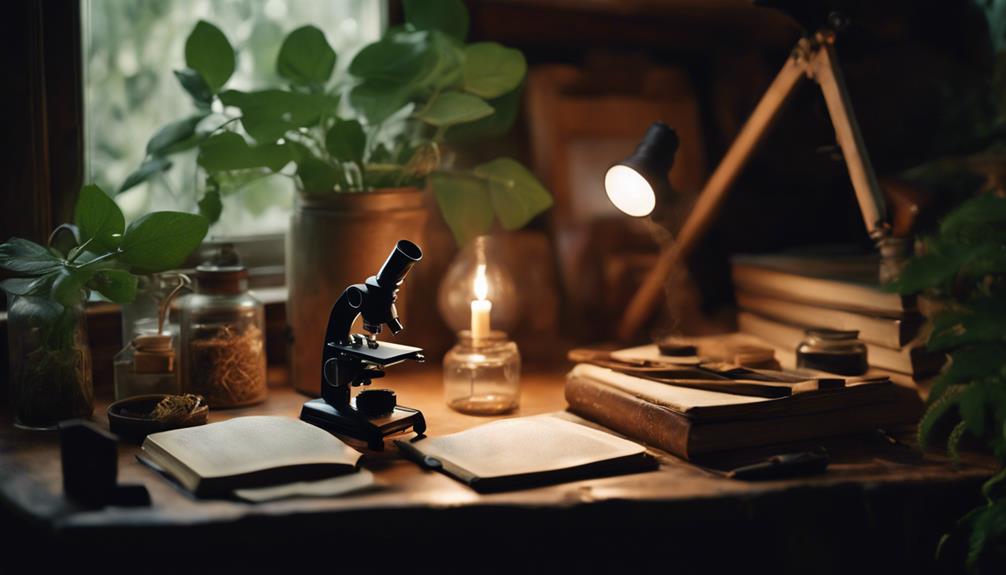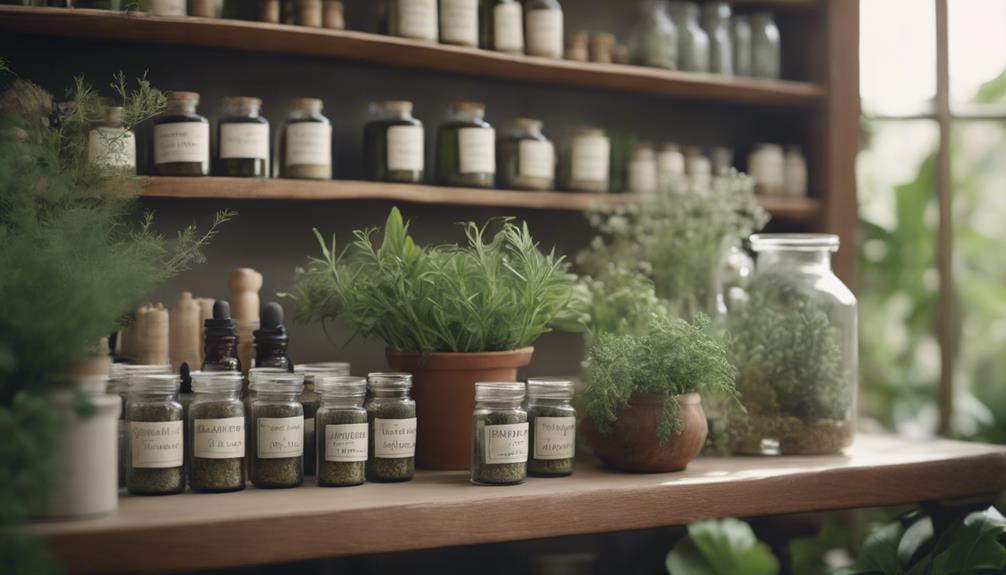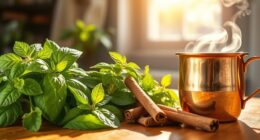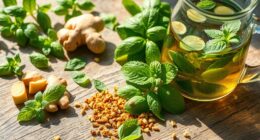We've found that the first recorded female herbalist in history is Hildegard of Bingen, a medieval mystic and composer born in 1098. She authored detailed works on herbal remedies, establishing herself as a pioneering figure in the field of herbalism. Her faith and religious beliefs influenced her healing approach, which emphasized the interconnectedness of the natural world and health. Her works, 'Physica' and 'Causae Et Curae', showcase her extensive knowledge of herbal remedies, including medicinal uses of plants like fennel, horehound, and valerian. As we explore her life and contributions, we'll uncover the rich legacy of this medieval trailblazer.
Key Takeaways
• Hildegard of Bingen is considered the first female herbalist in history, born in 1098 during the Middle Ages.
• She was a renowned mystic, composer, and herbalist who wrote extensively on herbal remedies in her works "Physica" and "Causae Et Curae".
• Hildegard's holistic approach to healing emphasized the interconnectedness of the natural world and health, using plants like fennel, horehound, and mint.
• Her faith and religious beliefs influenced her healing approach, which focused on the mind-body connection and natural remedies.
• Hildegard's contributions to herbalism paved the way for future generations of female herbalists, solidifying her position as a pioneering figure in the field.
Hildegard's Life and Times
Born in 1098, we find ourselves in the midst of a remarkable era, one that would shape the life and legacy of Hildegard of Bingen, a trailblazing German abbess. As we explore her life, we're struck by the significance of her existence during the Middle Ages. Hildegard's birth marked the beginning of a remarkable journey, one that would take her from humble beginnings to becoming a renowned mystic, composer, and ultimately, the first female herbalist in history.
Growing up, Hildegard's life was deeply rooted in her faith, which would later influence her approach to healing. Her visions and religious beliefs played a pivotal role in shaping her understanding of the natural world and its connection to human health.
As we investigate her life, it becomes clear that Hildegard's unique blend of spirituality and scientific curiosity laid the foundation for her groundbreaking work in herbalism. We're about to embark on a fascinating journey, one that will reveal the remarkable story of Hildegard of Bingen, a true pioneer in the world of herbalism.
Early Contributions to Herbalism

During Hildegard's time, we find ourselves at the dawn of a new era in herbalism, where her unique blend of spirituality and scientific curiosity laid the foundation for her groundbreaking contributions to the field.
As we fast-forward to the 18th century, we're introduced to Elizabeth Blackwell, a pioneering female herbalist who made significant contributions to the field.
Here are some key aspects of Blackwell's work:
- Scientific accuracy: Her herbal, 'A Curious Herbal', showcased her dedication to precision and attention to detail.
- Artistic talent: The botanical illustrations in her herbal weren't only informative but also aesthetically pleasing.
- Determination and creativity: Blackwell created her herbal to help release her husband from debtors' prison, demonstrating her resourcefulness in the face of adversity.
- Pioneering spirit: Through her work, Blackwell paved the way for future female herbalists and botanical illustrators, leaving a lasting legacy in the field of herbalism.
Blackwell's work was a reflection of her expertise in botany and artistic talent, making her a trailblazer in the field of herbalism.
As we continue to explore the history of female herbalists, we're reminded of the significant impact these women have had on the development of herbalism as it stands today.
Physica and Causae Et Curae

As we explore Hildegard's seminal works, Physica and Causae Et Curae, we find a thorough and pioneering approach to herbalism that showcases her profound understanding of the natural world and its healing properties.
Written in the 12th century, Physica details Hildegard of Bingen's extensive knowledge of herbal remedies and their medicinal properties. Causae Et Curae, on the other hand, focuses on the causes and treatments of various illnesses, emphasizing the importance of natural remedies.
Hildegard's holistic approach to healing is evident in her use of herbs, plants, and other natural elements to promote well-being. Her work in Physica and Causae Et Curae demonstrates a deep understanding of the interconnectedness of the natural world and human health.
A Pioneer in Medieval Medicine

As we explore Trotula's groundbreaking contributions to medieval medicine, we'll examine her innovative approaches to healing, which centered around the use of herbs and natural remedies to treat various ailments.
Her pioneering work in this field not only showcased her expertise in women's health but also highlighted the significance of botanical treatments in addressing a range of health issues.
Medieval Healing Practices
We explore the medieval era, where herbal remedies and passed-down knowledge formed the foundation of healing practices, with women playing an essential role in shaping the course of medieval medicine.
During this period, herbalism was an integral part of healthcare, with women serving as healers and herbalists in their communities. They relied on their knowledge of medicinal plants, passed down through generations, to create remedies for various ailments.
Here are some key aspects of medieval healing practices:
- Herbal remedies: Medieval healers used plants and herbs to create medicines, often relying on trial and error to develop effective treatments.
- Passed-down knowledge: Healers learned from their predecessors, building upon existing knowledge to develop new remedies and treatments.
- Women's role: Women played a significant role in medieval herbalism, often serving as healers and herbalists in their communities.
- Expertise in women's health: Female physicians like Trotula were known for their expertise in women's health and herbal medicine.
These practices laid the foundation for future advancements in medicine, with medieval women making significant contributions to the field of herbalism.
Herbs and Remedies
In the realm of medieval medicine, we discover the pioneering spirit of female herbalists, who leveraged their intimate knowledge of herbs and remedies to heal and transform the lives of those around them. These women, often overlooked in historical records, played a crucial role in developing and utilizing herbal remedies to treat various ailments.
They cultivated and harvested medicinal plants, creating concoctions and potions that soothed the sick and injured. Their extensive knowledge of botanicals allowed them to craft remedies for everything from fever and inflammation to skin conditions and digestive issues. By experimenting with different combinations of herbs, they created complex remedies that addressed specific health concerns.
As we explore the history of herbalism, we're reminded of the significant contributions women made to the field, often behind the scenes. Through their meticulous documentation and oral traditions, we're able to uncover the rich legacy of female herbalists, who continue to inspire and educate us today.
The Renaissance of Herbal Knowledge
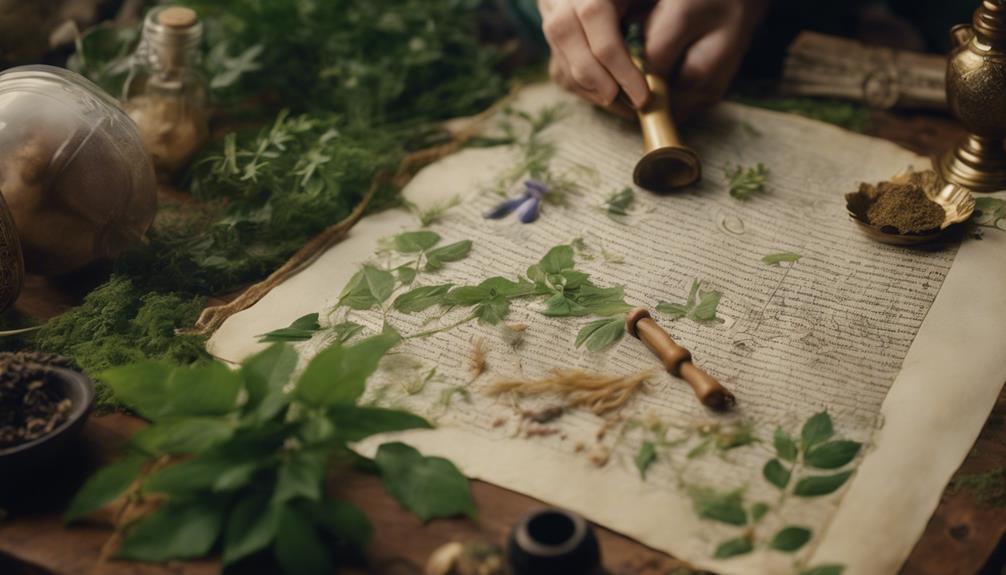
During the 15th to 17th centuries, a renewed fascination with medicinal plants swept through Europe, sparking a Renaissance of herbal knowledge that would transform the way people understood and utilized botanical remedies.
We witnessed a surge in interest in herbal medicine, as individuals explored ancient texts to uncover the secrets of medicinal plants.
Here are some key aspects of this Renaissance of herbal knowledge:
- Studying the ancients: Herbalists examined the works of Dioscorides and Galen to understand the properties of plants.
- Publication of herbals: numerous books detailing the medicinal qualities of plants and their applications in healthcare were published.
- Sharing knowledge: Herbal knowledge was disseminated through books, lectures, and apprenticeships, contributing to the spread of botanical wisdom.
- Women's role: Women played a significant role in herbalism during the Renaissance, contributing to the understanding and use of medicinal plants.
As we explored the world of herbal medicine, we discovered the significance of this period in shaping our understanding of botanical remedies.
The Renaissance of herbal knowledge laid the groundwork for future generations to build upon, and we're excited to further investigate the world of herbalism.
Women in Early Herbalism

As we explored the Renaissance of herbal knowledge, it became clear that women played a significant, albeit often overlooked, role in shaping the course of herbalism. We've found that women have been involved in herbalism for centuries, making substantial contributions to botanical knowledge and medicinal practices.
While the first female herbalist in history remains unknown due to limited documentation, women like Elizabeth Blackwell made a lasting impact on the field. Blackwell, a prominent female herbalist, published 'A Curious Herbal' in the 18th century, becoming the first woman to publish an herbal in Europe. Her work showcased her expertise and artistic talent, featuring detailed botanical illustrations and medicinal descriptions.
Through her publication, Blackwell demonstrated that women could excel in botanical studies and herbal medicine, paving the way for future generations of female herbalists. Her work not only contributed to the field of herbalism but also inspired others to follow in her footsteps.
As we explore further into the history of herbalism, it's evident that women like Blackwell played an important role in shaping our understanding of botanicals and their medicinal properties.
Hildegard's Herbal Remedies

As we explore Hildegard's herbal remedies, we'll uncover the medicinal uses of various plants, examine her natural healing methods, and discuss how they contribute to holistic health practices.
From fennel to chamomile, we'll look at how these remedies were used to treat ailments and promote overall wellness.
Medicinal Uses Unveiled
What secrets lie hidden in the ancient plants that Hildegard so meticulously documented, and how did she tap into their medicinal potential to create remedies that would soothe the sick and suffering? As we investigate Hildegard's work, we uncover the medicinal uses of the plants she documented. Her thorough knowledge of botanical medicine is impressive, to say the least.
Here are some examples of her remedies:
- Fennel: used to treat digestive issues and alleviate symptoms of indigestion and bloating.
- Horehound: employed to soothe respiratory issues, such as coughs and congestion.
- Valerian: utilized to promote relaxation and improve sleep quality.
- Mint: used to calm digestive issues and reduce nausea.
Hildegard's approach to healing was holistic, focusing on balancing the body's humors and promoting overall well-being through natural remedies. Her contributions to herbalism were significant, shaping medieval medicine and continuing to inspire herbalists and natural healers today.
As we explore her work, we're reminded of the importance of understanding the medicinal potential of plants, and the impact they can have on our health and well-being.
Natural Healing Methods
We turn our attention to Hildegard's natural healing methods, where her herbal remedies took center stage in promoting overall well-being. Her holistic approach to healing combined medicinal plants with spiritual beliefs, showcasing the importance of plants in maintaining health. We can see this in her documented works, 'Physica' and 'Causae et Curae', where she highlights the significance of plants in her herbal remedies.
| Plant | Ailment |
|---|---|
| Lavender | Anxiety and Insomnia |
| Fennel | Digestive Issues |
| Chamomile | Promoting Relaxation |
Hildegard's herbal remedies were designed to treat various ailments, from anxiety and insomnia to digestive issues. Her contributions to herbal medicine continue to inspire modern herbalists and holistic practitioners today. By understanding the natural healing methods of Hildegard, we can appreciate the significance of plants in promoting overall well-being. Her work has left a lasting impact on the world of herbal medicine, and her legacy continues to grow.
Holistic Health Practices
Through her pioneering work in herbal medicine, Hildegard of Bingen pioneered holistic health practices that continue to influence modern alternative medicine. We're fascinated by her emphasis on natural remedies, which she believed could restore balance to the body and spirit. Hildegard's holistic approach recognized the interconnectedness of physical, emotional, and spiritual well-being.
Here are some key aspects of her holistic health practices:
- Mind-body connection: Hildegard believed that the mind and body are intertwined, and that emotional balance is essential for physical health.
- Natural remedies: She advocated for the use of natural remedies, such as herbs and plants, to treat various ailments.
- Balanced lifestyle: Hildegard emphasized the importance of a balanced lifestyle, including a healthy diet, regular exercise, and adequate rest.
- Spiritual wellness: She believed that spiritual wellness is vital for overall health, and encouraged practices like meditation and prayer.
The Art of Medieval Healing

As we explore the medieval era, we find that the art of healing was deeply rooted in the use of herbs and plants, which played a pivotal role in the primary form of healthcare during that time.
Herbal remedies were a staple in medieval medicine, and monks and nuns in monasteries were renowned for their expertise in cultivating and utilizing medicinal plants. These herb gardens, carefully tended by the monastic orders, provided a constant supply of medicinal plants, which were used to treat various ailments.
Medieval herbalists combined folklore, religious beliefs, and empirical knowledge to create remedies that addressed a range of health issues. Elizabeth Blackwell's Curious Herbal, a detailed guide to medicinal plants, is a demonstration of the importance of herbalism in medieval healthcare.
As we delve further into the art of medieval healing, it becomes clear that the use of herbs and plants wasn't only a practical solution but also a deeply ingrained aspect of medieval culture. By examining the role of herbalism in medieval healthcare, we gain a deeper understanding of the resourcefulness and ingenuity of our ancestors in the face of limited medical knowledge.
Hildegard's Legacy in Herbalism

Among the most influential figures in medieval herbalism is Hildegard of Bingen, a German abbess and mystic who made significant contributions to the field in the 12th century. We're still feeling the impact of her work today, as her all-encompassing manuscript, 'Physica,' continues to inspire modern herbalists and alternative medicine practitioners worldwide.
Hildegard's legacy in herbalism is a proof of her innovative approach, which emphasized the importance of maintaining balance in the body through natural remedies.
Here are just a few ways Hildegard's work continues to influence herbalism:
- Holistic approach: Hildegard's integration of spiritual beliefs and holistic healing principles paved the way for a more thorough understanding of herbal medicine.
- Detailed documentation: Her intricate descriptions of over 200 plants and their medicinal uses in 'Physica' remain an invaluable resource for herbalists.
- Emphasis on balance: Hildegard's focus on equilibrium and harmony in the body continues to shape our understanding of health and wellness.
- Inspiration for modern practitioners: Hildegard's work serves as a foundation for many modern herbalists and alternative medicine practitioners, inspiring new generations of healers.
Hildegard's contributions to herbalism are a proof of her groundbreaking work, and we continue to benefit from her innovative approach to health and wellness.
A Lasting Impact on Medicine

We can still feel the reverberations of Elizabeth Blackwell's groundbreaking work in the field of herbal medicine, where her meticulous illustrations and medicinal knowledge have left an indelible mark.
Her publication, 'A Curious Herbal,' set a new standard for medical texts, showcasing the importance of accurate botanical illustrations and detailed medicinal information. As the first woman in Europe to publish an herbal, Blackwell's work has had a lasting impact on medicine, influencing the study and use of medicinal plants for generations to come.
Her contributions have paved the way for other women to make significant contributions in the botanical and scientific domains. Blackwell's work hasn't only elevated the field of herbal medicine but has also raised the bar for medical texts, emphasizing the importance of precise illustrations and thorough information.
Her legacy continues to inspire and inform medical professionals, students, and enthusiasts alike, solidifying her place as a pioneer in the history of herbalism.
Frequently Asked Questions
Who Are the Famous Female Herbalist?
We're curious about famous female herbalists! Besides Elizabeth Blackwell, we are aware of Maria Sibylla Merian, a 17th-century German naturalist, and artist who documented medicinal plants in her travels.
Who Was the First Herbalist?
As we flip through the dusty pages of history, we find that the first herbalist was likely a ancient Sumerian, around 4500 BC, who scribbled recipes on clay tablets, paving the way for future generations of healers.
Who Was the First Female Medical Doctor?
We're exploring the first female medical doctor, and we've discovered Metrodora, a 5th-century Greek physician who made groundbreaking contributions to women's health, paving the way for future female medics.
Who Is the Father of Herbalism?
"We thought we'd be the first to ask, but it's an old question – who is the father of herbalism? Surprise, it's not a father figure at all, but rather the ancient Greek physician Dioscorides, dubbed the 'Father of Herbalism'."
Conclusion
As we explore Hildegard's remarkable journey, we're left wondering: what if the world had ignored her groundbreaking work? Fortunately, her contributions didn't fall on deaf ears.
Hildegard's pioneering spirit, coupled with her meticulous documentation, has left an indelible mark on the domain of herbalism. Her work continues to inspire, educating generations on the art of medieval healing.
As we investigate further into the intricacies of her remedies, we're reminded that the seeds of innovation, sown centuries ago, still bear fruit today.




